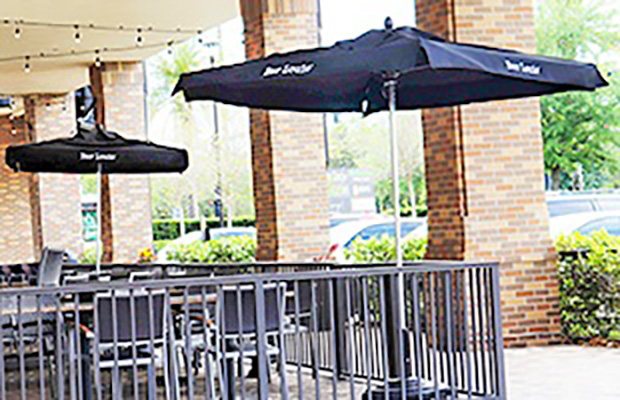 Every part of restaurant design is important — the furniture, the lighting, the decor. But the more prosaic surfaces in the restaurant, like floors, walls and ceilings, are just as important in making an overall impression on the guest. Moreover, they have a direct effect on the day-to-day operation of the restaurant.
Every part of restaurant design is important — the furniture, the lighting, the decor. But the more prosaic surfaces in the restaurant, like floors, walls and ceilings, are just as important in making an overall impression on the guest. Moreover, they have a direct effect on the day-to-day operation of the restaurant.
Take floors, for example. Especially in the back of house, slip and grease resistance is an absolute must. Floors that are easy to maintain and sanitize will save staff time and labor. Heavy-traffic areas, such as the passage from kitchen to dining room, may need extra heavy-duty flooring. And in the kitchen, where the food prep staff may be standing for hours at a time, comfort is also a consideration.
Wall coverings have to be more than merely decorative. In the dining area, they can help manage acoustics so patrons can hear each other talk. But they also have to be resistant to scuffs and abrasions (watch where you’re putting that chair!). While appearance may be less important in the back of house, it’s crucial that the walls there be easy to clean, moisture-proof and resistant to mold.
Ceilings also help manage the sound level in the dining area, and have to work in conjunction with the lighting and sound systems to provide an aesthetically pleasing surface that’s not harsh on the eyes or ears.
The stories on the following pages are loaded with ideas to help make your walls, floors and ceilings not only look great but perform efficiently as well.
The Importance of Wall Protection in Kitchen Hygiene
What part do walls play in keeping kitchens hygienic/sanitary?
 Chris Kephalas: Walls are an integral part of keeping kitchens hygienic. Walls need to be easy to clean, resistant to temperature changes, resistant to high moisture, and free of all gaps that can trap dirt and bacteria.
Chris Kephalas: Walls are an integral part of keeping kitchens hygienic. Walls need to be easy to clean, resistant to temperature changes, resistant to high moisture, and free of all gaps that can trap dirt and bacteria.
In terms of cleaning and hygiene, how important is the choice of wall coverings in a restaurant?
CK: It’s all about understanding the environment where you are installing your wall protection and selecting the “fit for purpose” product that provides long-term cleanability and durability. Operators sometimes make the decision of going straight to the most cost-effective wall panel without understanding what the long-term challenges may be. They could face hard-to-repair wall damage and bacteria buildup, including mold and mildew. If tile is installed, there is no guarantee that an epoxy grout will be used. If the wrong grout is used, there will be a challenge with mold and mildew growth in the grout itself. If a highly textured wall panel is chosen for covering up scratches, the challenge is the cleanability. Because highly textured panels are not smooth, they are not easy to wipe down. The wrong product installed in the kitchen could cause food safety issues that could lead to shutdown by local health authorities.
How is the “open kitchen” concept affecting kitchen walls today?
CK: Aesthetics is a growing priority in design criteria; therefore, installing functional walls is not enough anymore. You can’t just install a typical wall panel, painted walls or tiles, like you would in the typical back-of-house kitchen. You need something that’s more aesthetically pleasing because it’s now part of the restaurant. The kitchen itself is an important part of the overall client experience.
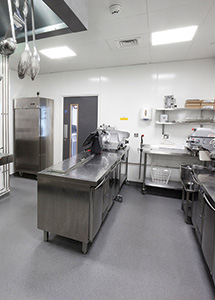 Maintaining clean, sanitary walls is critical in avoiding food safety issues.
Maintaining clean, sanitary walls is critical in avoiding food safety issues.
What is Altro Puraguard, and why is it different?
CK: Puraguard is a 2-mm-thick PVC wall panel available in 4-by-9-feet and 4-by-10-feet lengths. Unlike other wall panels, it won’t crack or release fibers if damaged, which is extremely important when you’re talking about people’s food! Puraguard is designed to resist the growth of mold, fungi and other bacteria that can put restaurant staff as well as customers at risk.
Talk a little about the testing that Puraguard has conducted to ensure protection against common hygienic issues like mold and mildew growth.
CK: It’s important that you need some form of wall protection in the kitchen, something that’s made from an inert material like vinyl or plastic. Puraguard was subjected to a mold growth test, the ASTM D3273. In this test, samples were exposed to mold spores under ideal temperatures and humidity, and progress was recorded after each week. After four weeks of ideal conditions, Puraguard didn’t show any sign of growth. Not all products are tested this way.
What other benefits does Puraguard provide?
CK: Puraguard offers more than just a wall covering or wall panel system. It’s impact-resistant; it’s got excellent cleanability and UV stability. It’s cost-effective and easy to install. It’s also Class A Fire rated, and not all wall panels can say that.
Enhancing Walls, Floors and Countertops with Daltile
A Q&A with Amber Leigh Martinson, Director of Marketing, Daltile
What trends are you seeing in restaurant walls and flooring these days?
 Amber Leigh Martinson: Some of the hottest trends we are seeing are seamless spaces, marble and concrete looks, as well as mixed metals incorporated within a design space or even a single product. Because of this movement, there is a growing demand for extra-large porcelain slabs, which allow you to achieve this incredible style without sacrificing performance or blowing your budget. With fewer grout lines and the appearance of natural stone, porcelain slabs create seamless bathroom designs, high-impact amenity spaces, epic hospitality entrances and bring a “wow factor” to other areas, enhancing the guest experience, inside or out. This trend does not stop at interior design. You see this trend everywhere in the market, from office supplies, furniture accents to phone cases and more.
Amber Leigh Martinson: Some of the hottest trends we are seeing are seamless spaces, marble and concrete looks, as well as mixed metals incorporated within a design space or even a single product. Because of this movement, there is a growing demand for extra-large porcelain slabs, which allow you to achieve this incredible style without sacrificing performance or blowing your budget. With fewer grout lines and the appearance of natural stone, porcelain slabs create seamless bathroom designs, high-impact amenity spaces, epic hospitality entrances and bring a “wow factor” to other areas, enhancing the guest experience, inside or out. This trend does not stop at interior design. You see this trend everywhere in the market, from office supplies, furniture accents to phone cases and more.
Stains and maintenance issues are a big problem with many materials, correct?
ALM: While care and maintenance is usually a big concern when selecting products, extra-large format porcelain slabs have many benefits — one being a highly resistant surface. For instance, the Panoramic Porcelain Surfaces™ assortment from Daltile® has little to no maintenance required. In addition to being very easy to clean and maintain, Panoramic has the lowest water absorption rate and is also resistant to heat, frost, chemicals, staining and scratching.
.jpg) A stylish look is achieved through the use of Daltile Panoramic Porcelain Surfaces™ Stonewall Coal on the bar countertop. What if there is a tight budget for the overall project?
A stylish look is achieved through the use of Daltile Panoramic Porcelain Surfaces™ Stonewall Coal on the bar countertop. What if there is a tight budget for the overall project?
ALM: Panoramic Porcelain Surfaces slabs are one of the most versatile products Daltile offers by easily bringing the scale and style of authentic natural stone slab to projects where they may be cost or installation prohibitive. They can also be used in tile-over-tile applications — especially in restaurants/hotels — to provide a green cost savings by eliminating the tear-out of existing tile. Enjoy the versatility to install on walls, floors and countertops with a seamless aesthetic that harmonizes floor, wall and countertop patterns.
How do Daltile’s Panoramic Porcelain Surfaces™ differ from other products?
ALM: Panoramic is manufactured using state-of-the-art equipment producing a high-quality hybrid pressed panel. Inventory is stocked at locations nationwide to make the product readily available for projects across the country, and we continuously expand the line with trend-setting designs and styles. Additionally, we offer FlexFit™ Size Solutions, a program offering the full Panoramic assortment in smaller, stocked sizes or the flexibility to custom cut-to-size these slabs to any shape or design.
What are the end-user benefits in the FlexFit™ Size Solutions “One Slab Fits All” concept?
ALM: Our goal in providing a “One Slab Fits All” solution is to allow for complete customization of the space. Our seven stocked, standard sizes offer popular modular sizes, readily available for time-sensitive projects while our custom cut-to-size capability allows designers the ability to transform a full slab into their unique artistic vision.
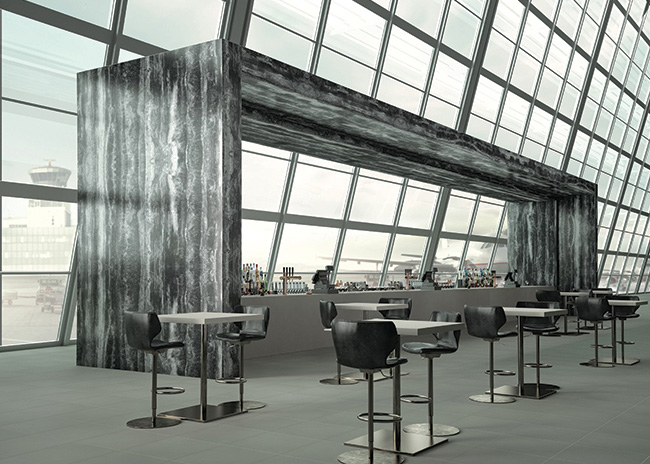 Panoramic Porcelain Surfaces™ Titanium Grey brings a dramatic look to a high-traffic airport lounge.
Panoramic Porcelain Surfaces™ Titanium Grey brings a dramatic look to a high-traffic airport lounge.
Aspecta and the Biophilic Design Trend
A Q&A with Robert Langstaff, Director of Design, Aspecta
What exactly is “biophilic design”?
 Robert Langstaff: Biophilic design is a conscious effort to integrate nature into the built environment in meaningful ways. It’s not just about making something beautiful; it’s about providing something that will connect the interior with the people who will use it. Research proves that biophilic designs can produce measurable improvements in how people experience the built environment. That is why biophilic design now drives the creation of Aspecta products.
Robert Langstaff: Biophilic design is a conscious effort to integrate nature into the built environment in meaningful ways. It’s not just about making something beautiful; it’s about providing something that will connect the interior with the people who will use it. Research proves that biophilic designs can produce measurable improvements in how people experience the built environment. That is why biophilic design now drives the creation of Aspecta products.
How does it apply to restaurants?
RL: There is a quality to biophilic design initially found in the health care industry. People responded positively and recovered faster when they were exposed to biophilic elements and biophilic design, such as windows and sunlight. I think the same is true whether it’s in the office, at home or in restaurants. People respond to this in a very positive way; it’s very inviting.
A restaurant meal should be enjoyed in a nurturing environment. Rather than a hard-surfaced, angular and industrial space, a biophilically influenced environment with natural forms, softer lighting and beautiful views helps us relax and have a better dining experience.
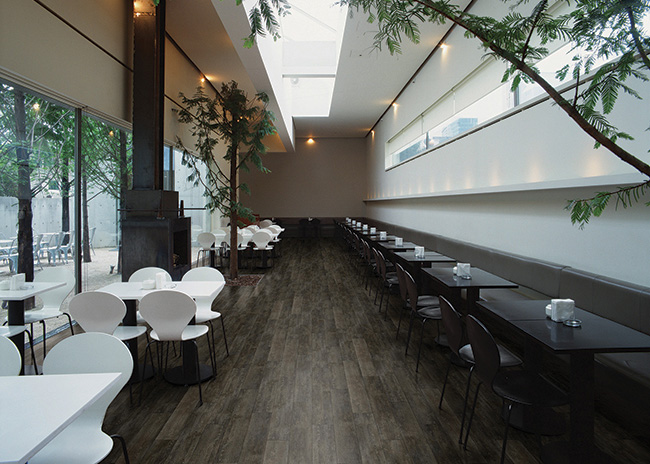 Aspecta Five flooring in the Mason Oak design brings the “look of outdoors” inside.
Aspecta Five flooring in the Mason Oak design brings the “look of outdoors” inside.
Is it something only for high-end restaurants or is it applicable to all types of operations?
RL: Yes. Even chain restaurants could use this. People want a restaurant to be relaxing and comfortable.
How can biophilic design be used for restaurant flooring?
RL: Flooring can be the pathway to biophilic design — literally, the groundwork to integrating it into a commercial environment. As designers, that’s where we should start to build the desired atmosphere we want to achieve for the space. Resilient flooring effectively replicates natural materials and patterns, making it one of the most versatile yet low-maintenance materials to help achieve biophilic design objectives. Biophilic design appeal in flooring also occurs whenever there’s an interplay of light and shadow: diffuse and variable, integrated with spatial properties.
 Biophilically designed Aspecta Tilt & Tones will debut in March 2019.
Biophilically designed Aspecta Tilt & Tones will debut in March 2019.
How is Aspecta integrating biophilic design into its product line?
RL: At Aspecta, we have inherently used biophilic influences in our designs — wood grains, stone or even abstract looks inspired by nature — for decades. We know these looks resonate most deeply with designers, architects and end users.
We are applying biophilic design elements and principles in our line of luxury vinyl tile (LVT) flooring. The Aspecta One Ornamental collection, for example, builds on reclaimed materials with innovative, nature-inspired design motifs.
Coming in March 2019, our Tilt & Tones flooring incorporates two biophilic design elements. The collection features 24-inch by 24-inch tiles presented in four color groups. Each consists of four unique Tilt tile designs that can be paired with two companion Tones tiles. The Tilt design was inspired by geometric shapes created in the shadows that the sun casts on outdoor surfaces such as deserts and beaches. The Tones evolved from the look of fabric-embossed ceramics and natural stone-based colors, expressed in neutral colorways. The range reflects Aspecta’s immersion in biophilic design as an influence in the creation of our ever-evolving product lines.
Rigidized® Metals and Performative Beauty
 A Q&A with Kevin Porteus, Architectural Project Manager
A Q&A with Kevin Porteus, Architectural Project Manager
What do you mean by the phrase “performative beauty”?
Kevin Porteus: The phrase “performative beauty” comes from the acoustical and durability performance of our acoustical panels due to the deep texturing and acoustical mat enveloped in the panel, combined with the beauty that our deep texturing provides in the material.
What are the benefits texturized metals provide beyond just being an attractive surface?
KP: The deep texturing provides greater impact resistance. It hides the scratching and denting that occurs on surfaces in high-traffic areas. Aesthetically, you don’t see the scratches in a deep-textured metal because while the scratch is there, it’s only on the very top part of the deep-textured pattern. So it’s not a continuous scratch line, and aesthetically, it becomes nonvisible.
Is maintenance difficult?
KP: No. In fact, when people ask us for maintenance information, we provide very simple guidelines provided by the Specialty Steel Institute of North America (SSINA). The easiest form of cleaning is just a mild detergent in warm water. Wipe it down, rinse it off with a wet cloth, and then dry it.
 At the (716) Food & Sport in Buffalo, N.Y., acoustical panels from Rigidized® Metals add a dramatic design element.
At the (716) Food & Sport in Buffalo, N.Y., acoustical panels from Rigidized® Metals add a dramatic design element.
Let’s talk about Rigidized® Metals’ acoustical panels.
KP: With a 1-inch-thick Johns-Manville acoustical mat with a 33 percent open-textured perforation, we have an NRC rating of about .76. That is a good NRC rating, especially for a metal acoustical panel. So you get the acoustical benefits and also the aesthetic appeal that the deep texturing provides. We can either do it in a stainless steel finish or now we have introduced powder coating. So you can also add color to it…any color you can think of from the powder coat spectrum.
How do Rigidized® Metals’ acoustical panels bring “performative beauty” to a restaurant operation?
KP: With that performative beauty in the stainless steel or a powder coat, it can fit almost any environment. Since all of our acoustical panel projects are custom made, we can fit it to almost any application. We’ve done ceiling panel projects and wall panel projects. You can run these acoustical panels all the way down to the floor because of the durability of a deep-textured metal acoustical panel. They have the durability to survive quite well in a high-traffic area.
Our acoustical panels are a turnkey system. We make our panels on a custom basis to the project size requirements, and they come with a Z-rail fastening system. So it’s a very easy install and can get shipped right to the jobsite, ready to install by the contractor.
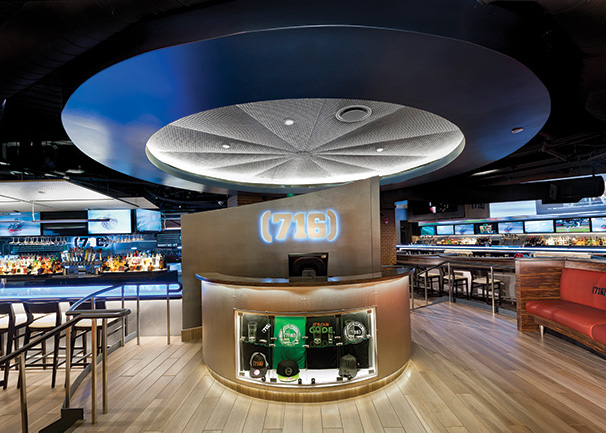 The (716) Food & Sport bar/restaurant uses a variety of metal acoustical panels in its design. Photos courtesy of Jim Cavanaugh Photography
The (716) Food & Sport bar/restaurant uses a variety of metal acoustical panels in its design. Photos courtesy of Jim Cavanaugh Photography
What sets Rigidized® Metals’ acoustical panels apart from other panels?
KP: We’re one of the very few metal acoustical panels available in the market. When we add the deep texture to it, it simply enhances the panel’s aesthetics and furthers the durability. People like the idea of a metal acoustical panel for the durability and with our .76 NRC rating, that’s a sufficient rating to be included in a lot of applications.
At Rigidized® Metals, we like to say, “we take metal and make it better.”
Adding Texture and Drama to Walls and Ceilings
A Q&A with Krystle Gentry, ATI Marketing Director
What trends are you seeing in restaurant wall coverings or ceilings?
Krystle Gentry: We’re seeing a surge of interest in rich metallics
like chrome and copper, as well as lighter woodgrains with a carved-wood look. Restaurants are combining these finishes with unique textures to set themselves apart while giving the warmth of nostalgia. Designers no longer feel limited to plain ceilings, either. They’re rediscovering this “fifth wall” as a surface with tremendous design potential. Designers now have many more options — even custom options are much more accessible than before.
How can walls and ceilings affect the overall mood or look of a restaurant?
KG: The classic advice on wall and ceiling colors remains relevant — lighter colors open rooms up, while darker tones make rooms look more intimate. However, restaurants are no longer limited to color alone. Texture adds interest and drama to otherwise-neglected surfaces, and even sound-absorbing ceiling tiles can enhance the dining experience. These are experiential details that diners appreciate.
What benefits do MirroFlex wall panels and ceiling tiles offer to restaurants?
KG: MirroFlex offers three-dimensional wall panels in 4x8 and 4x10 sizes at a much better price point than other textured products on the market. There are thousands of pattern and finish combinations to choose from — perfect for any modern or traditional design. MirroFlex Ceiling Tiles offer great alternatives to tin and acoustic ceilings, available in 2x2 and 2x4 sizes. MirroFlex has many features beneficial to restaurant environments, including easy installation, impact and scratch resistance, Class A Fire rating, and easy-to-clean surfaces.

